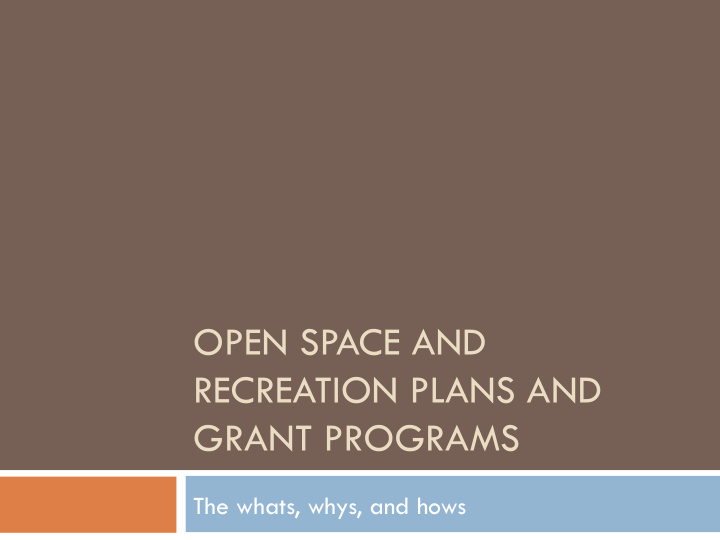



OPEN SPACE AND RECREATION PLANS AND GRANT PROGRAMS The whats, whys, and hows
What is an Open Space and Recreation Plan (OSRP)? ¨ A document that describes a community’s open space and recreation resources ¨ It is also a blueprint for action for open space and recreation decision-makers in a community ¤ Conservation Commission ¤ Parks Commission ¤ Cemetery Commission ¤ Planning Board ¤ Local citizens
What is open space? ¨ Conservation land, forest land, agricultural land, parks, green buffers along roadways, or any open area that is ¨ Also refers to undeveloped land with particular conservation or recreation interest, including vacant lots and brownfields that can be redeveloped into recreation areas, even community gardens ¨ Most of this land is owned by an agency or organization dedicated to conservation or recreation, but not all open space is protected
Why write an OSRP? ¨ Integrates many sources of data into one comprehensive picture of a community’s natural resources ¨ Educates residents about conservation and recreation issues and increases awareness of local resources ¨ Identifies actions that will protect and manage community’s resources
Why write an OSRP? ¨ And, it makes communities eligible to apply for grants through the Division of Conservation Services
What are the OSRP requirements? ¨ The Open Space and Recreation Planner’s Workbook details the requirements (www.mass.gov/Eoeea/ docs/eea/dcs/ osrp_workbook08.pdf) ¨ Nine sections in the plan, highlights of which are the inventory of open space and the action plan
What is the process of writing an OSRP? ¨ First step is starting an Open Space and Recreation Committee ¨ Members can come from local boards, interested citizens, and municipal employees ¨ The lead author of the plan can be a volunteer, a municipal employee, graduate student, or a consultant (in some cases)
What is the process of writing an OSRP? ¨ Many times the OSRP sections are divvied up and a responsible party (or group of people) will be identified for each ¨ Everyone should help with the public participation process, which is the most important part of the planning process
What are other important components of an OSRP to be aware of? ¨ Public participation process ¤ Can take on many forms – survey, public meeting, workshop, etc. ¤ Can combine different types – you know your community best ¤ Helps to gather information on what community members feel is important to protect, what recreational activities they’d like to see, etc. ¤ Also helps to inform the community about the importance of open space and recreation in their community
What are other important components of an OSRP to be aware of? ¨ Maps ¤ Regional Context ¤ Environmental Justice (if applicable) ¤ Zoning ¤ Soils and Geologic Features ¤ Unique Features ¤ Water Resources ¤ Open Space Inventory ¤ Action Plan
What are other important components of an OSRP to be aware of? ¨ Open Space Inventory ¤ Lists all municipally-owned conservation and recreation properties only ¤ Includes information on management agency, zoning, public access, condition, recreation potential, etc. ¨ Action Plan ¤ Is now a Seven-Year Action Plan (instead of five) ¤ Lists actions that will implement the plan’s goals and objectives with a responsible party, potential funding source, and priority associated with each
What are other important components of an OSRP to be aware of? ¨ Americans with Disabilities Act Accessibility Report ¤ Administrative requirements ¤ Inventory of conservation and recreation properties only ¤ Employment practices
What is the OSRP approval process? ¨ Once the community has written the plan, a hard copy is submitted to the Division of Conservation Services for review and approval ¨ A letter is sent to the community with any additions and/or changes that are required – the plan expires seven years after this letter is written ¨ Once those issues are addressed in a final plan, the community will receive a final approval letter
Who can I call for help? ¨ Helpful resources are listed in the Open Space and Recreation Planner’s Workbook (on our website) ¨ State agencies, as well as local and statewide non- profits ¨ Me! ¤ melissa.cryan@state.ma.us ¤ (617) 626-1171 ¤ www.mass.gov/eea/dcs-grants
What’s Melissa’s contact information? Melissa Cryan 100 Cambridge Street, 9 th Floor Boston, MA 02114 (617) 626-1171 melissa.cryan@state.ma.us www.mass.gov/eea/dcs-grants
Recommend
More recommend